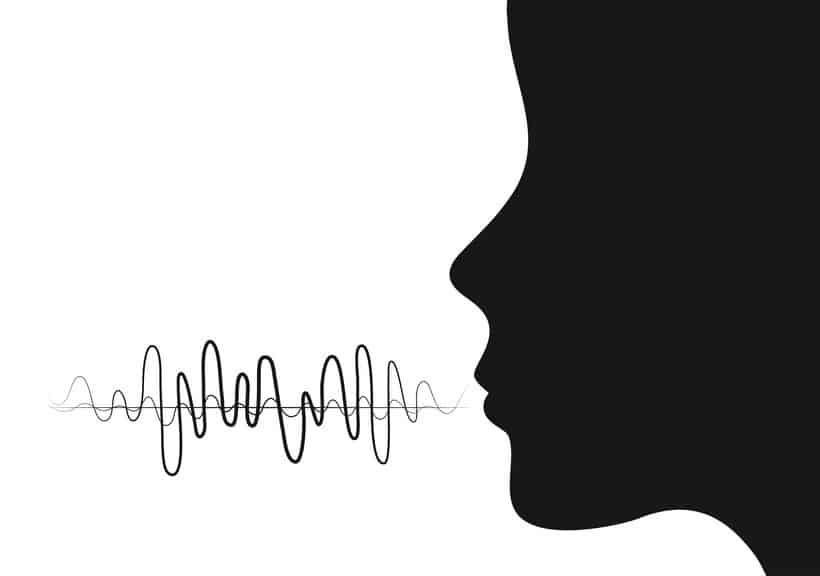If you’re a singer, you’ve almost certainly heard the terms “head voice” and “chest voice.” And while you may have heard the term “falsetto,” you may not know what it sounds like. Many singers may think the unique tone of falsetto won’t work with their style of music. But that being said, mastering falsetto can significantly affect your singing ability.
Using a Falsetto Voice: A Guide
1. What is Falsetto?
The word falsetto means “false voice,” but a falsetto is certainly real. It’s a high voice that sits above your modal register. The modal register is just your normal voice, and it includes head voice, chest voice, and mixed voice. It often has a breathy sound that doesn’t have as many overtones as the head voice or chest voice. Some people call it a “mickey mouse” voice because it sounds a little like a cartoon character: in many situations, it just sounds false.
In some circles, falsetto is only considered to be part of the male vocal range. However, there’s also a female falsetto voice, as falsetto is produced by a distinct physical process in the vocal folds (we’ll go into more detail on this later). That said, you often don’t hear falsetto in female singers being discussed as often as falsetto in male singers.
Generally, falsetto is used more by the tenor voice than it is by soprano, alto, or bass voices. Its main purpose is to let someone (often a male voice) sing high notes they may not otherwise be able to reach.
Historically, the falsetto has been used in classical music and choral music. Often, the alto line in a given choral piece had alto men and boys singing in falsetto. Many genres of popular music also use falsetto as an effect today, too. If you’re interested in falsetto and why it’s such an enduring part of music, check out this informative video!
2. What’s the Difference Between Falsetto and Head Voice?

Most singers have a decent understanding of vocal registers. But it’s easy to get confused when it comes to head voice and falsetto.
Falsetto relies largely on the cricothyroid muscle to produce higher notes. But the vocal cords are also used differently in falsetto and head voice. The entire length of the vocal cord will vibrate in your chest voice, head voice, or middle voice. But when you use a falsetto to hit high notes, only the very edges of the vocal cords will vibrate.
Though either your head voice range or falsetto might be considered an upper register, there are some key differences between the two voices. You get a thinner and distinctly breathy sound when you use falsetto to sing higher.
By contrast, when a singer uses a head voice to hit high notes, the high voice you hear has a fullness and warmth to it that falsetto just doesn’t have. Sometimes it helps to hear the difference between head voice and falsetto. This video offers examples of both types of voices and also helps explain the difference between the two.
3. How is Falsetto Voice Produced?
It’s not absolutely essential for singers to know how the vocal folds and surrounding muscle groups work together to produce high notes in falsetto. But sometimes, knowing how our voices work can help with visualizations, breath support, etc.
When you use falsetto, your vocal folds are largely relaxed, though the edges are tense, leaving a permanent oval orifice between them. In order to produce high notes, vocal cords need to be long, but the lengthening process that happens in falsetto is unique.
First, the vocalis muscle relaxes. This muscle is the main part of the vocal cord. When this muscle relaxes, the cricothyroid muscle then engages. This is one of the muscles essential to singing in falsetto. Cricothyroid muscles put a good bit of tension on vocal ligaments. And as you know if you play guitar, a tight, thin string will usually have a higher pitch than a thicker, shorter string.
The vibrations across these vocal ligaments produce the distinctive part of your upper range we now as falsetto. If this sounds complex, you’re not alone. And often, singers who do a lot of falsetto work have taken time to develop their voices. Because the process of producing falsetto is so much different from head voice or chest voice, It’s completely understandable that working on it would be necessary. If you want to take a closer look at how your vocal cords work when you sing, check out this cool video!
4. When Should You Use Falsetto?
As we’ll see in a moment, some singers make a career out of falsetto singing. But for most voices, it’s not desirable to sing falsetto all or most of the time.
But if you want to expand and explore your upper range or just want to add another texture to a song, it might be worthwhile to use it. But most vocal coaches and experienced singers suggest using it as more of an effect than as a regular mode of singing.
There’s a good reason behind that guidance — if you routinely sing in a falsetto voice with great power, you may cause substantial vocal damage. In a similar vein, you really don’t want to rely only on falsetto because you have to do so. After all, this voice should just be an item in your toolbox to help you sing high notes. It shouldn’t be the only voice you use!
If you’re a singer who wants to add a little bit of a breathy texture to important moments in a song, that’s where falsetto can serve you best. Just like a key change in a song, changing between voices can be a useful and effective way to signal a shift. This video offers several useful exercises for perfecting the “falsetto flip,” or the change between chest voice and falsetto.
5. What Famous Singers Use Falsetto?

Just like learning any other vocal technique, learning falsetto singing gets a little easier if you have some exemplary voices to use for inspiration. Chances are good that you’ve heard a falsetto singer or two; you can find them in popular music and classical music alike. You’ll notice that this list includes more men than women, as women tend to rely more on their head voice to hit high notes.
Here are a few singers who use falsetto you can use as examples or inspiration:
- Sam Smith
- Michael Jackson
- Beyonce
- Chris Brown
- Thom Yorke
- Prince
- Justin Vernon (of Bon Iver)
- Jeff Buckley
- Leona Lewis
- Elton John
- Brian Wilson
- Justin Timberlake
There are a couple of useful videos you might want to check out if you’re interested in learning from some great falsetto singers. This video (above left) will introduce you to the top 10 male falsetto of all time (according to the video maker!). And this video (above right) offers examples of high notes sung in head voice, whistle register, or falsetto to help you differentiate.
6. Why Develop Your Falsetto?

When it comes to strengthening your head voice or chest voice, most singers are all for doing vocal exercises. But when they think about learning to sing falsetto, both men and women sometimes hesitate.
However, even if you don’t routinely need to hit higher notes when you sing, developing your falsetto has a good number of benefits for you as a vocalist. Before we jump into exercises for developing falsetto, here are some benefits of working on this unique vocal register:
It gives you better vocal control. If you’ve just begun trying to sing high notes in falsetto, you may find that you run into some difficulty staying on pitch. Some of that is due to the fact that there’s a gap between your vocal cords while singing falsetto.
But practicing falsetto until you can reliably stay on pitch, you’ll develop better vocal control in all registers. Just like weightlifters will sometimes talk about a mind-muscle connection, singers can benefit from a more conscious connection to the muscles of the vocal tract.
It helps you strengthen breath support. As you may already know, falsetto is usually not a register with a whole lot of power behind it. So in order to sing in a balanced, pleasant-sounding falsetto, you need to make sure you have adequate breath support. And to maintain that breath support, you will usually need to rely on diaphragmatic breathing.
Of course, breath support and diaphragmatic breathing aren’t unique to falsetto. As you develop these skills, you’ll likely become stronger in every other vocal register, too.
It lets you reach higher notes. Falsetto lets you reach higher notes than you can get in your natural range. And while many singers don’t count notes that they can reach in falsetto as part of their natural range, your falsetto range will usually overlap with your head voice. Sometimes, that overlap can even be a full octave. So as you work on your falsetto, you may find that your head voice can reach higher notes than you thought, too.
It can help you reach lower notes. This one is certainly a surprise! You already know that working on your falsetto helps you sing high notes. But it will also help you expand your vocal range in the other direction.
That’s because singing in falsetto involves significant relaxation of many parts of your vocal cords. As you get comfortable singing in at least a partially relaxed state, you’ll find that you’re able to produce even lower tones.
It can strengthen your vocal process as a whole. Just like athletes for a given sport often cross-train, vocalists will often work to strengthen all-vocal muscles. If you develop your falsetto, you will strengthen various muscles involved in singing. When you have a strong voice in general, you’ll be able to sing more expressively and with a better tone.
If you want some guidance on improving your falsetto, check out this helpful video!
7. How Do You Develop Falsetto?
Just like working on any register, working on your falsetto takes physical effort. And if you’ve done some work on improving your chest voice or head voice, you might be familiar with vocal and breath exercises. If you’re ready to sing falsetto better than before, here are some exercises to help you do so:
The Mickey Mouse. This one sounds silly, but it’s actually a great warm-up. Start talking in a Mickey Mouse voice while watching yourself in the mirror. You want to make sure that you’re relaxing, as a relaxed body is essential for a great falsetto. In particular, make sure you’re relaxing your jaw, shoulders, neck, and tongue.
The siren. Especially in people who have not trained in falsetto singing, an “ooo” sound is easiest to make. One way to get more comfortable in falsetto is to mimic a siren with a high-pitched note. Try doing this as high as you can. It’s important to not let worry about how you sound get in the way. For the purposes of this exercise, you just need to reach a legitimate note. It doesn’t matter if it sounds terrible!
The break. If you’ve ever spent time working on developing a mixed voice, you may have done a variant of this exercise. As you practice singing up in pitch to do a siren sound or hit a note, you’ll probably run into a break in your voice. This is normal! But if you want to be able to get rid of it, you’ll need to practice singing “over” or “through” the break. This takes some time, but you can oven erase the break entirely if you practice correctly and enough.
The full song. This exercise might not sound quite as specialized, but it’s a great way to build your range and strengthen your falsetto. To do this, pick a song you like and practice singing it in different (mostly higher) octaves. If you can’t quite tell if you’re in another octave, don’t worry; you just need to sing it in a higher pitch. It will probably sound breathy and a bit thin, but it should strengthen over time.
Of course, these exercises are designed for people new to singing falsetto. If you need someone advanced exercises, this resource will show you some!
Want to Learn More?
You’ve probably heard plenty of people suggest seeing a voice teacher if you want to improve the volume, tone, or overall quality of your voice. But did you know you can get quality vocal instruction online as well? With an online voice lesson program, you can learn from experienced singers on your own time.
Of course, if you’re trying to overcome a break in your voice or get better at singing falsetto, individual feedback makes a difference. But in many cases, online programs let you send videos and audio files to your teachers for individualized feedback!
Final Thoughts
Singing falsetto is a great vocal skill to have, but don’t worry if you can’t master it right away. It often takes time to be able to sing falsetto with confidence.
But what do you think? Do you have any tips or insights on learning to sing in a falsetto voice? Let us know in the comments, and please don’t forget to like and share if you found this list useful!
